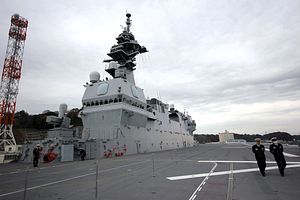In a few short years, Japan will have its first real aircraft carriers since World War II. The modification of JS Izumo and JS Kaga to carry the F-35B Joint Strike Fighter will upend, or at least update, nearly seven decades of defense thinking in Japan, and across East Asia. The combination of the Izumos with the F-35B Lightning II stealth fighter and the MV-22 Osprey transport may herald Japan’s return to serious naval competition in East Asia, with reverberations in South Korea, China, and the United States. It may also fundamentally change the identity and culture of the Japanese Maritime Self-Defense Force (JMSDF) and the rest of the Japanese armed forces.
The Izumo class began life in 2009 as a development of the Hyuga class. Hyuga and Ise, 646-foot long flat-decked warships displacing 19,000 tons at full load, were the first dedicated aircraft-carrying ships built by Japan since the end of World War II. They were also nearly twice the size of the Shirane class destroyers, the ships they were intended to replace.
The Hyugas raised eyebrows because of their size and appearance, which seemed to strongly resemble European aircraft carriers capable of operating STOVL (short take-off/vertical landing) fighter aircraft. However, the JMSDF did not have access to the AV-8B Harrier or a similar jet, and for the time being seemed to have little interest in developing the Hyugas into offensive platforms. Instead, the Hyugas would perform an anti-submarine mission, as well as use their amphibious capabilities for humanitarian assistance and disaster relief (HADR).
The Izumos soon followed the Hyugas, beginning construction not long after the latter first entered service. Nearly half again as large as the Hyugas, the Izumos are 814 feet long and displace 27,000 tons at full load. This placed them at the upper end of the light carrier spectrum, similar in size to the Spanish Juan Carlos I and the Italian Cavour. Japan insisted that the ships would have a similar mission to the Hyugas, however, and it made no immediate effort to acquire F-35Bs or Harriers.
The decision to rapidly expand Japan’s naval aviation capabilities nevertheless raised eyebrows. The JMSDF undertook considerably greater expense in designing and building the Izumos rather than simply building another two Hyugas. It hardly escaped notice that the JMSDF, which had labored through the entire Cold War and post-Cold War period without any large flat-decked aircraft carrying ships, suddenly needed not just two but four, and also needed to rapidly escalate the size and capabilities of those ships.
Of course, international trends were important. The opening two decades of the post-Cold War era saw the rapid proliferation of flat-decked aircraft-carrying warships with amphibious capabilities. A great number of navies began to see value in flat-decked ships that could conduct sea control missions, could show the flag around the world, and could offer a means for making an independent contribution to multilateral military and humanitarian operations. The large amphibious warships of the U.S. Navy made a big impact in Southeast Asia in the wake of the 2004 tsunami. Tokyo was watching, as were Seoul and Beijing. That all three major powers in Northeast Asia began to invest in amphibs is not surprising, but Japan’s particular path seemed odd.

































